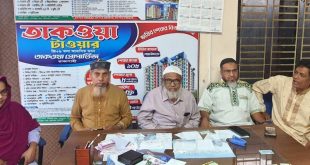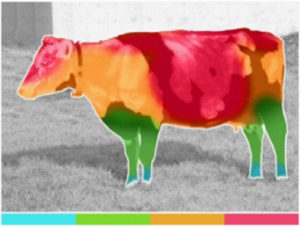 Heat stress is a common and growing concern in dairy production, and we are now fully aware that it is not limited to operations in hot climates. A 2016 study from Penn State University about smart farming technologies to monitor heat stress indicators (rumination, rumen temperature, rumen pH, etc.) revealed a clear correlation between environmental heat stress levels, rumination time and milk production. With each 10-point increase in the Temperature Humidity Index (THI) — for instance, an increase from 22 to 30°C with 50% relative humidity — daily rumination could be reduced by 1 hour and dairy production by 2.7 Kg/day (6 lbs.) (Haan, 2016).Thanks to such technologies, producers can anticipate production issues and take the right farm management decisions. This is a path towards precision farming that, at Lallemand Animal Nutrition, we have been taking for many years by developing a rumen efficiency audit program based on animal and environmental indicators. This program is known as the Rumen Efficiency Investigation (REI) software. Its goal is to help producers and nutritionists assess feed efficiency in real-life working farm conditions. Today, this tool has been widely used (in more than 25 countries) in different production systems and farms. The data collected gives us an overview of the global rumen efficiency situation. Such data indicate that, in line with previous industry and university studies, overall, around 50% of farms are exposed to rumen efficiency issues. Reviewing data obtained under heat stress conditions, we find this ratio is significantly increased — indicating the real toll of heat stress on rumen efficiency.
Heat stress is a common and growing concern in dairy production, and we are now fully aware that it is not limited to operations in hot climates. A 2016 study from Penn State University about smart farming technologies to monitor heat stress indicators (rumination, rumen temperature, rumen pH, etc.) revealed a clear correlation between environmental heat stress levels, rumination time and milk production. With each 10-point increase in the Temperature Humidity Index (THI) — for instance, an increase from 22 to 30°C with 50% relative humidity — daily rumination could be reduced by 1 hour and dairy production by 2.7 Kg/day (6 lbs.) (Haan, 2016).Thanks to such technologies, producers can anticipate production issues and take the right farm management decisions. This is a path towards precision farming that, at Lallemand Animal Nutrition, we have been taking for many years by developing a rumen efficiency audit program based on animal and environmental indicators. This program is known as the Rumen Efficiency Investigation (REI) software. Its goal is to help producers and nutritionists assess feed efficiency in real-life working farm conditions. Today, this tool has been widely used (in more than 25 countries) in different production systems and farms. The data collected gives us an overview of the global rumen efficiency situation. Such data indicate that, in line with previous industry and university studies, overall, around 50% of farms are exposed to rumen efficiency issues. Reviewing data obtained under heat stress conditions, we find this ratio is significantly increased — indicating the real toll of heat stress on rumen efficiency.
Relevant criteria to assess rumen efficiency
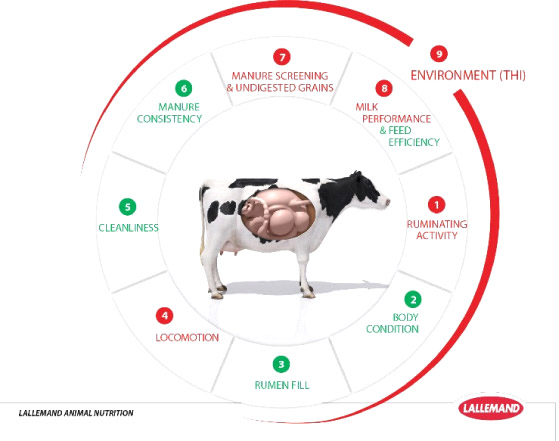
The REIis a holistic approach based on the assessment of a set of measurable indicators at the farm level. There are nine indicatorsin total, selected by integrating bibliography reviews, practical dairy farm surveys and international expert views, and validated in the field (Fig. 1).These indicators are linked to:
- Animal performance: milk production, components, somatic cell counts,etc.
- Animal observation: ruminating activity, locomotion, rumen fill, body condition score, cleanliness.
- Manure observation: manure consistency and screening.
- Environmental conditions: temperature and humidity (the THI index).
Global survey: heat stress impacts somekey rumen indicators
Through the REI, data was collected in farms under various conditions. All data obtained during the hot seasons were combined and Figure 2 gives an overview of the risk levels for five indicators within the heat stress risk period.
- Rumination activityis linked to rumen function and health. According to the literature, a good target is to have 50-60% of cows lying in their stalls ruminating.The overall REI data indicates that rumination is suboptimal in 69% farms.Under heat stress conditions, this figures increases to include 86% of farms. This is in line with a study showing that rumination activity is correlated to heat stress (Haan, 2016).
- The link between locomotion and rumen health is well established in the literature. Lame animals can have high levels of histamine production and bacteria endotoxin release in the rumen, which is often linked to SARA (Nocek, 1997). Independent of the THI, the REI survey showed that in 72% of the farms audited, locomotion represents a challenge. Similar resultswere observed under heat stress conditions.
- Manure screening is recommended to measure the presence of undigested particles or grains and assess fiber size. The presence of undigested processed grains in the feces is linked to poor rumen efficiency. It also results from increased passage rate due to an imbalanced or low diet digestibility. Under heat stress conditions, 61% of farms have a risk of insufficient grain digestion. In the overall survey, 51% of farms showed insufficient grain digestion.
- Finally, milk component yield is a consequence of rumen efficiency. The REI survey shows that, under high temperature-humidity conditions, milk fat/protein ration is insufficient in 87% of farms. Moreover, somatic cell count is at risk in 46% of farms. When looking at average values for hot vs. colder seasons, there is a statistical difference in the milk component ratio and somatic cell count (Fig. 3). This confirms the effect of heat stress not only on milk quantity yield, but also on the quality of the milk produced, with potential implications on milk cost. In addition to financial implications, a high somatic cells count is a sign of poor health status.
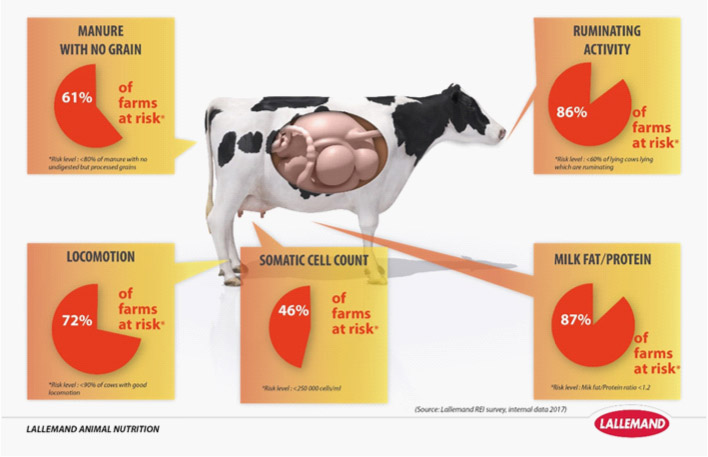
Figure 2: How dairy farms perform under heat stress conditions according to 5 key rumen efficiency indicators (Lallemand internal data, 2017)
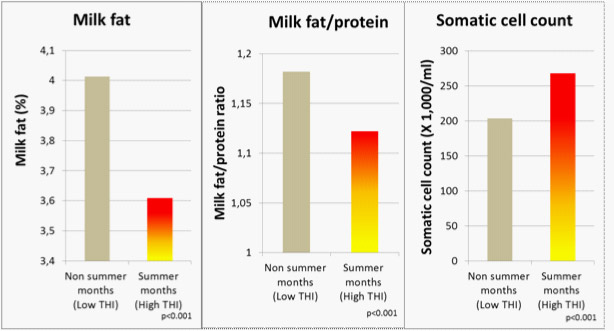
This survey indicates that, under heat stress conditions, while feed intake is reduced, rumen efficiency appears sub-optimal, as demonstrated by early signs such as rumination, grain digestion, locomotion and milk composition.
Live yeast benefits
Heat stress is not limited to two summer months or tropical regions and could be an issue for long periods. By monitoring THI within the animals’ environment (in the barn) — but also assessing visible indicators such as rumination, locomotion or undigested grains in manure — producers can better anticipate heat stress issues and make the necessary adjustments before dairy production starts falling.
Among the nutritional measures shown to alleviate heat stress, the use of the rumen-specific live yeast Saccharomyces cerevisiae CNCM I-1077 (LEVUCELL SC) shows positive effects on the rumen environment and, consequently, dairy production. The rumen-specific live yeast acts as a rumen modifier. It works by improving the overall rumen environment and function through the control of rumen pH. S. cerevisiae CNCM I-1077 also helps improves animal performance through enhanced fiber degradation.
Several studies, conducted in partnership with universities, have demonstrated that S. cerevisiae CNCM I-1077 increases animal performance (feed efficiency and milk yield), rumen pH and improves early signs of rumen efficiency (e.g., fiber in the feces, rumination, manure consistency, etc.). In standard conditions (non-stressful), a meta-analysis of LEVUCELL SC data (14 trials, 1,600 dairy cows) has shown a consistent and significant improvement of feed efficiency by +3% in FCM/DMI (De Ondarza, 2010).This improvement can increase by 6 to 9% under heat stress conditions (Table 1).
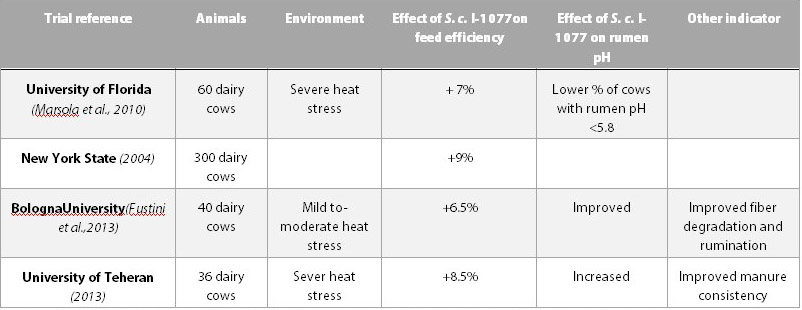
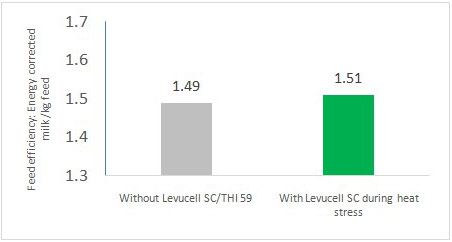
This scientific evidence is supported by field experiences. For example, a farm trial was conducted in Japan under heat stress conditions (April- August 2017; THI 69-78) in order to assess the effect of LEVUCELL SC during summer in non-acidotic conditions on milk performance and rumen efficiency indicators, using the REI software. The audits were performed before the supplementation, with THI=59, and then after 1.5-, 2.5- and 4 months supplementation, with a THI between 69 and 78.
This farm trial confirms beneficial effects on rumen efficiency indicators: while rumination was sub-optimal before, this was improved despite heat stress: 50% of cows were ruminating before supplementation (THI 59) and this figure increased to 63% of cows with LEVUCELL SC — despite a high THI. Other indicators such as rumen fill and cow cleanliness were also improved during supplementation. Moreover, the milk fat/protein ratio was maintained above 1.2 (a low risk level) despite heat stress. Finally, the live yeast not only alleviated the impact of heat stress on dairy cows, but it also improved the performance when compared to a non-stressful period: overall feed efficiency and income-over-feed costs are improved during the hot season as compared to low THI period (Fig. 4).
In conclusion, to quote M. Haan from PennStatein his article: “Producers, nutritionists, veterinarians, and other consultants within the dairy industry could make better use of the data already being generated on farms by existing technologies and should be prepared to take advantage of new technologies as they become available.”The REI software and data that can be obtained can give practical indications about a herd’s status and can help better manage feeding and animals. As shown by the global survey, heat stress has a strong impact on rumen indicators and more than half the farms audited show sub-optimal rumen efficiency. Among the nutritional tools available to support rumen efficiency under stressful conditions, rumen-specific live yeast S. cerevisiae CNCM I-1077 iswell documented and backed by several controlled trials. Such benefits can be seen at the farm level thanks to REI audits.
For further information and scientific resources about the rumen and potential challenges that can be found on farm, please visit: RuminantDigestiveSystem.com.
References:
de Ondarza M. B., Sniffen C. J., Dussert L., Chevaux E., Sullivan J.,and Walker N., 2010. Multiple-Study Analysis of the Effect of Live Yeast on Milk Yield, Milk Component Content and Yield, and Feed Efficiency. The Professional Animal Scientist 26:661–666
Fustini M., Palmonari A., Durand H., Formigoni A., and Grilli E. 2013. Effect of Saccharomyces cerevisiae CNCM I-1077 (Levucell SC) on rumen pH and milk production during heat stress. J. Anim. Sci. Vol. 91, E-Suppl. 2/J. Dairy Sci. Vol. 96, E-Suppl.
Haan M.M. Using Rumination Sensors to Monitor Heat Stress in Dairy Cows. Penn State Extension, Dairy Herd Management, November 02, 2016 https://extension.psu.edu/using-rumination-sensors-to-monitor-heat-stress-in-dairy-cows
Marsola R. S., M. Favoreto, F. T. Silvestre, J. H. Shin, A. T. Adesogan, C. R. Staples, and J. E. P. Santos. 2010. Effect of feeding live yeast on performance of Holstein cows during summer. J. Anim. Sci. 88 (S2)/J. Dairy Sci. 93 (S1): 432
Nocek J. E. 1997. Bovine Acidosis: Implications on Laminitis. J Dairy Sci 80:1005-1028.
source : Lallemand Animal Nutrition
 Agrinews24 কৃষির সাথে, কৃষকের পাশে
Agrinews24 কৃষির সাথে, কৃষকের পাশে


















